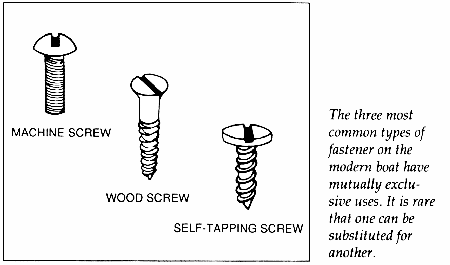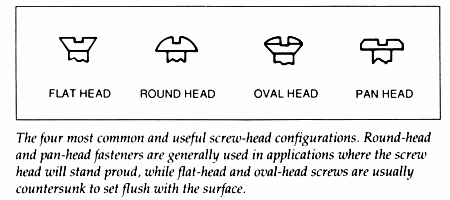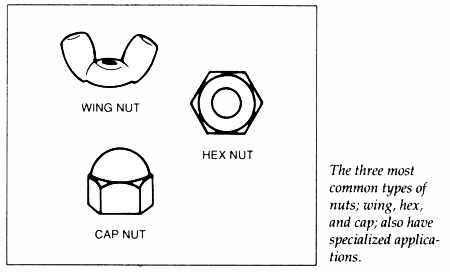- Home
- THE PROPER FASTENER
THE PROPER FASTENER
|
From "The Practical Sailor Library - Volume IV - Do-It-Yourself Improvement Projects"
Do you remember Richard III's lament about losing a battle for lack of a nail? By contrast, use a nail in a fiberglass boat and it is likely that the boat will be lost. Nails, as well as wood screws, have few applications on a modern boat. The reason is simple: Almost any fastener will do a better job than either.
The most practical fastener material is stainless steel. Stain-less steel is strong, corrosion-resistant, and galvanically the most passive of fastener materials with the exception of bronze. Best of all, stainless steel fasteners are commonly available, even in areas where an anchor is regarded as an odd example of free-form sculpture.
Let's take a close look at the choice of fasteners available to the do-it-yourself boatowner:
Screws Self-tapping screws work almost as well in most woods as they do in metal. They come in a variety of head configurations in sizes up to #14, and in lengths from 1/4 inch to 3 inches. Just like a wood screw, a self-tapper can be countersunk and. bunged, or set with the head flush. Where self-tapping screws truly excel is in fastening into fiberglass laminates, whether cored or solid. They should be used to carry light loads only, however; they are not a substitute for bolts for heavier loads. As with any screw, the strength of the fastening itself is generally greater than its holding power (it will pull out before it will break off). As a rule of thumb, the laminate into which the screw is driven should be at least equal in thickness to the diameter of the screw.
For all their virtues, self-tapping screws do have some notable limitations and drawbacks. The number of times they can be removed and redriven is finite; sooner or later they wear out the hole, diminishing their holding power. Holding power is also reduced if the pilot hole is oversized, and they may be impossible to drive if the pilot hole is undersized. Remember too that the holding power of the screw is no greater than the strength of the material into which it is driven. Soft woods, thin laminates, and thin metals cannot carry much of a load. Conventional wood screws are superior for fastening wood joinerwork, but they should never be used to fasten into fiberglass laminates.
Bolts
Rivets Pop-rivets are available in both aluminum and stainless steel, with the stainless steel ones use for heavier loads. The center pin is pulled, expanding the body of the rivet, until the pin breaks ("pops"). They may be set up with either a hand tool or a hydraulic tool. A word of warning: Squeezing the hand tool is a macho exercise, difficult for the aluminum rivets, herculean for the stainless steel. Removing rivets entails drilling them out, a job that must be done carefully to prevent enlarging the holes in which replace-ment rivets must fit. In removing rivets (for stripping a mast for painting, for instance), you may want to plan from the outset to use the next larger diameter when you replace the rivets. * * *
And finally, keep in mind that a well found yacht does not need an infinite variety of fastener sizes and types. A typical 35-footer can be built with just a few basic fasteners: 3/16-inch and 1/4-inch flathead machine screws in two or three different lengths, a box or two of #8 and #10 self-tapping screws in 3/4 and 1-1/4 inch lengths, and a couple boxes of #8 wood screws for the joiner work. Where the underside of a bolt or screw is hidden, the excess length makes no difference except to a racing sailor for whom any extra weight is a cause for fantods. Of course, don't leave the excess length exposed where it can cause an injury or snag a sail.
|




